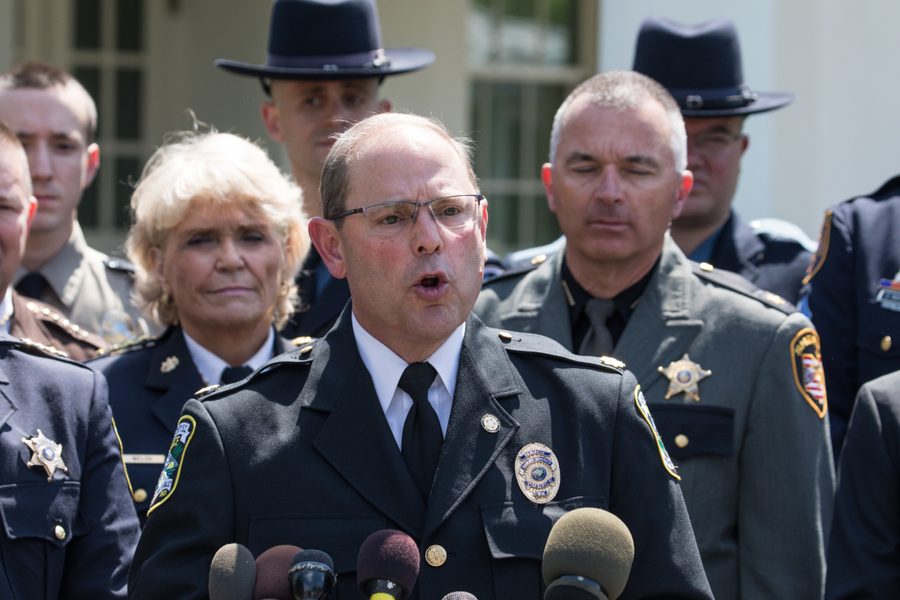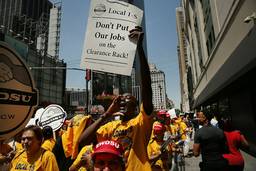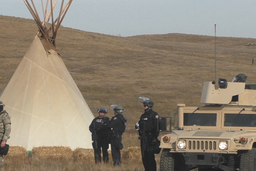
This week, in an address to the biennial conference of the Fraternal Order of Police (FOP), Attorney General Jeff Sessions announced that President Donald Trump had issued an executive order allowing local law enforcement to, once again, receive bayonets, tracked armored vehicles and grenade launchers from the Pentagon. For free.
Federal transfers of certain types of military hardware, but certainly not all, had previously been banned as part of former President Barack Obama’s efforts to reform a controversial Department of Defense (DOD) program known as 1033.
Since the 1990s, the DOD has distributed surplus equipment to law enforcement agencies through its Law Enforcement Support Office. While the majority of the equipment includes gear like computers and office supplies, the 1033 program also supplies weapons and tactical vehicles to local police for just the cost of shipping.
The system of distributing surplus gear to local police largely flew under the radar until the summer of 2014. That was when assault rifles and armored vehicles were used to confront protesters in Ferguson, Mo. following the killing of Black teenager Michael Brown. Although none of the armored vehicles used in Ferguson had been obtained through the 1033 program, the spectacle sparked a national debate over police militarization and led to new scrutiny of the Pentagon’s partnership with local police. The Black Lives Matter movement pushed the demand to demilitarize police departments into public discourse.
In May 2015, Obama issued an executive order that led to an outright ban on federal transfers of certain military-grade weaponry, including bayonets, .50 caliber guns, and tracked armored vehicles. The order established a new list of “controlled items” that police could obtain only after following an additional protocol. The restrictions also applied to programs administered by federal agencies, such as the Departments of Justice and Homeland Security, which also provide support to local law enforcement through grants or surplus equipment transfers.
Some argue that Obama’s restrictions were largely cosmetic. In 2015, Peter Kraska, an academic who has done extensive research on police militarization, criticized the “deceptive” packaging of these reforms. After all, several of the banned items — like weaponized aircraft — had never been distributed to local law enforcement to begin with.
Regardless, the powerful FOP has vigorously opposed Obama’s executive order from the outset. In a press statement released this week, the FOP’s senior legislative liaison, Tim Richardson, noted that the union had been “working to roll back these restrictions since the day they were announced.”
The world’s largest law enforcement officers’ union, the FOP represents more than 330,000 members in the United States and has staff who work full-time lobbying Congress on issues of concern.
The FOP has not been shy about its opposition to restrictions on police weaponry. In a 2016 issue of the quarterly FOP Journal, Jim Pasco, a senior union official who spearheaded the lobbying effort, slammed as “offensive and absurd” the notion that something like an MRAP would ever be “strictly controlled” by the federal government. Yet, the Obama-era reforms are limited, requiring, for example, that personnel receive training before handling military-grade equipment, like MRAPs.
In reality, the flow of “controlled equipment” like MRAPs has hardly slowed down in the wake of the reforms. In contrast to statements from police officials and Attorney General Jeff Sessions, who sometimes imply that 1033 had been “eviscerated” by Obama’s executive order, the reforms made hardly a dent in the program. The most recent figures, provided to In These Times by Defense Logistics Agency spokesperson Susan Lowe, show that $460 million worth of excess DOD equipment has been transferred to police departments so far this year.
In January, the FOP began pushing for new legislation in Congress that would undo the Obama-era restrictions on the 1033 program. While the union was working behind the scenes, it kept pushing its message to union membership and the wider public. In May, the cover story of the FOP Journal made the organization’s priorities perfectly clear: “Modernized, Not Militarized: Why Law Enforcement Needs Advanced Equipment.”
The FOP was not alone in its push to greenlight police militarization. David Griffith, the editor of one of the leading trade publications in policing, claimed last year that restricting the 1033 program may “cost lives.” Meanwhile, a PoliceOne editorial published in May 2015 speculated that crowds would now be allowed to “run amok because police don’t have the necessary protective equipment” to quell a riot.
Yet, research indicates that a militarized police force — with its accompanying garb and hardware — may lead to more aggressive encounters with the public. Support for this theory came last fall, when a heavily militarized police force hosed, teargassed and tackled water protectors at Standing Rock.
In case the legislative path should fail, the FOP’s Pasco held out hope for an executive action on the matter. But it was far from a sure thing. In May, when the FOP executive board met with President Donald Trump, a range of topics was discussed, but the 1033 program did not come up due to time constraints.
Commenting on the Attorney General’s speech this week, FOP President Chuck Canterbury expressed thanks for “such good news” coming out of the White House.
Kanya Bennett, legislative counsel for the American Civil Liberties Union, wrote on August 28 that, as a result of Trump’s action, “Weapons of war will again be used to police our communities, no questions asked.” She underscored that concerned individuals can ask their elected representatives to support the Stop Militarizing Law Enforcement Act, which would eliminate federal transfers of MRAPs and other gear to police. According to Bennett, “Communities must call out the federal government for instigating police militarization.”







